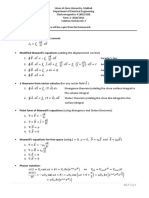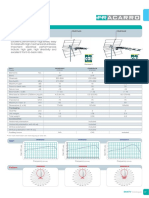Figure 3.1: A Cross-Guide Directional Coupler
Figure 3.1: A Cross-Guide Directional Coupler
Uploaded by
Super SpecialCopyright:
Available Formats
Figure 3.1: A Cross-Guide Directional Coupler
Figure 3.1: A Cross-Guide Directional Coupler
Uploaded by
Super SpecialOriginal Title
Copyright
Available Formats
Share this document
Did you find this document useful?
Is this content inappropriate?
Copyright:
Available Formats
Figure 3.1: A Cross-Guide Directional Coupler
Figure 3.1: A Cross-Guide Directional Coupler
Uploaded by
Super SpecialCopyright:
Available Formats
Experiment 3. Get familiarized with directional coupler.
Objective: To be familiarized with the operating principles of directional coupler. Also, to measure the coupling and
directivity of a directional coupler.
Discussion:
• A directional coupler is a four-port component made from two waveguides joined together such that a known
fraction of a microwave signal in one waveguide will couple a signal into the other waveguide.
• Directional coupler is commonly used to measure the power of transmitted and reflected signal without disturbing
the transmission.
• It is formed by joining two waveguide sections sharing a common wall (Figure 3.1) with openings in the common
wall.
Figure 3.1: A cross-guide Directional Coupler.
• The ratio of the incident power to the power of the coupled signal at the sampling port is called the coupling
factor. If the power is fed into port-1 and port-3 is the sampling or coupled port, then
𝑃1
𝐶 = 𝑐𝑜𝑢𝑝𝑙𝑖𝑛𝑔 𝑓𝑎𝑐𝑡𝑜𝑟 = 10 log 𝑑𝐵
𝑃3
• The ratio of the coupled power at the sampling port (port-3) to the coupled power at the isolated port (port-4)
when the power is incident at port-1 is called the directivity of the coupler.
𝑃3
𝐷 = 𝐷𝑖𝑟𝑒𝑐𝑡𝑖𝑣𝑖𝑡𝑦 = 10 log 𝑑𝐵 (𝑖𝑓 𝑝𝑜𝑤𝑒𝑟 𝑖𝑠 𝑖𝑛𝑐𝑖𝑑𝑒𝑛𝑡 𝑎𝑡 𝑝𝑜𝑟𝑡 1)
𝑃4
The directivity of a cross-guide directional coupler can vary from 20 to 40 dB.
Pre-lab 3
Q1. What is a directional coupler?
Q2. What would be the directivity of an ideal directional coupler?
Q3. Determine the power at ports 2, 3 & 4 for a directional coupler (C = 15 dB, D = 35 dB) when the incident
power at port 1 is 1 mW.
Q4. What is the purpose of ‘matched load’?
Equipment:
Gunn oscillator power supply (9501)
SWR meter (9502)
Gunn oscillator (9510)
Crystal detector (9522)
Directional coupler (9523)
2 Matched loads (9531)
Variable attenuator (9532)
Cables and accessories (9590)
Waveguide supports (9591)
Procedure:
1. Make sure that all power switches are in the “off” position and setup the module as shown in Figure 3.2:
Figure 3.2: Module arrangement.
2. Assemble the setup shown in Figure 3.3 below:
Figure 3.3: Setup used to obtain a reference reading.
3. Make the following adjustments on the Gunn oscillator power supply:
Voltage: Min Mode: 1 kHz Meter Range: 10 V
4. Select the -30 dB RANGE switch on the SWR meter and adjust the GAIN control knob to its maximum value. Select
the 20 Hz BANDWIDTH.
5. Power up the Gunn Oscillator Power Supply and the SWR meter. Wait 1-2 minutes. Adjust the Gunn Oscillator
Power Supply voltage to 8 V.
6. Adjust the Variable Attenuator for a reading of -30 dB on the SWR meter. This is the reference level:
𝑃1 = −30 𝑑𝐵
7. Disconnect the Gunn Oscillator power supply cable. Assemble the set-up of Figure 3.4. Make sure not to change the
setting of the Variable Attenuator.
Figure 3.4: Set-up used to measure the coupling factor.
8. Reconnect the Gunn Oscillator power supply cable.
9. Read the relative level (in dB) of the coupled signal on the SWR meter. Make sure not to change the GAIN control
knob of SWR meter. You might have to select appropriate RANGE on SWR meter.
Coupled Signal Level (𝑃3 ) = _______ dB
Figure 3.5: Set-up used to measure the directivity.
10. Calculate the coupling factor of the Directional Coupler
Coupling factor = 𝑃1 − 𝑃3 = −30 − 𝑃3 = ________ 𝑑𝐵
11. Select -30 dB RANGE on the SWR meter.
12. Adjust the Variable Attenuator to obtain a reading of -30 dB on the SWR meter. This is reference level for directivity
measurement:
𝑃3 = _______ 𝑑𝐵
13. Disconnect the Gunn Oscillator power supply cable. Assemble the set-up of Figure 3.5.
14. Reconnect the Gunn Oscillator power supply cable.
15. Select appropriate range on SWR meter and read the signal level at the isolated port.
Signal Level at the isolated port (𝑃4 ) = _______ dB
16. Calculate the directivity of the Directional Coupler
Directivity = 𝑃3 − 𝑃4 = ______ − ______ = ________ 𝑑𝐵
17. Turn the VOLTAGE control on the power supply to its MIN. Place all power switches in the off position.
You might also like
- Super-Heterodyne FM Receiver Design and SimulationDocument4 pagesSuper-Heterodyne FM Receiver Design and Simulationleo300150% (2)
- + Chelton: V/Uhf Receiver TYPE 707-I SERIAL Nos. 1 - 100Document51 pages+ Chelton: V/Uhf Receiver TYPE 707-I SERIAL Nos. 1 - 100dadanNo ratings yet
- Radharaman Institutes of Research & Technology Bhopal Department of Electronics and CommunicationDocument2 pagesRadharaman Institutes of Research & Technology Bhopal Department of Electronics and Communicationcrazy about readingNo ratings yet
- RFMW ManualDocument30 pagesRFMW ManualSRI HARSHA ACHINo ratings yet
- Experiment 10 - SwpdirectionalcouplerDocument18 pagesExperiment 10 - Swpdirectionalcoupler3nadhsNo ratings yet
- Microwave Lab ManualDocument64 pagesMicrowave Lab ManualPrannoy ChakravarthiNo ratings yet
- Lab 5Document4 pagesLab 5Super SpecialNo ratings yet
- Microwave Engineering Practical FileDocument13 pagesMicrowave Engineering Practical FileMohit Dutta100% (1)
- Radharaman Institutes of Research & Technology Bhopal Department of Electronics and CommunicationDocument2 pagesRadharaman Institutes of Research & Technology Bhopal Department of Electronics and Communicationcrazy about readingNo ratings yet
- Microwave Practile Bharati Vidyapeeth BE and MEDocument43 pagesMicrowave Practile Bharati Vidyapeeth BE and MESantosh PotdarNo ratings yet
- Microwave Devices: ObjectivesDocument7 pagesMicrowave Devices: Objectivesba beshaNo ratings yet
- Lab No.6: Measurement of Properties of A Directional CouplerDocument6 pagesLab No.6: Measurement of Properties of A Directional CouplerM. Ahmad RazaNo ratings yet
- Exp.: Measurement On Directional CouplersDocument5 pagesExp.: Measurement On Directional Couplersnirbhav_gambhirNo ratings yet
- Ex - No: Measurement of Coupling Factor and Directivity of The Directional Coupler Date: AimDocument5 pagesEx - No: Measurement of Coupling Factor and Directivity of The Directional Coupler Date: AimPrabin JoseNo ratings yet
- Laboratorio Microondas 3Document10 pagesLaboratorio Microondas 3Daniel CamiloNo ratings yet
- Frequency and Wavelength Measurement: Experiment-1Document3 pagesFrequency and Wavelength Measurement: Experiment-1dhawanrishNo ratings yet
- Ece481-Microwave and Optical Communication Laboratory ManualDocument44 pagesEce481-Microwave and Optical Communication Laboratory Manualeceklu100% (1)
- Oscillator ManualDocument22 pagesOscillator ManualckooipgNo ratings yet
- Lab#7 I&M 078Document9 pagesLab#7 I&M 078Asad saeedNo ratings yet
- Experiment No 11Document5 pagesExperiment No 11Shreeraj PandeyNo ratings yet
- Microwave Lab ManualDocument52 pagesMicrowave Lab ManualDhanish VijayanNo ratings yet
- Report6 122101031,33,30,35Document3 pagesReport6 122101031,33,30,35sambro5544No ratings yet
- MDC Lab ManualDocument74 pagesMDC Lab Manualmani kumarNo ratings yet
- Unit VIDocument43 pagesUnit VIraghavendra prasadNo ratings yet
- Experiment No 8: Aim: To Determine The Frequency & Wavelength in A Rectangular Waveguide Working inDocument5 pagesExperiment No 8: Aim: To Determine The Frequency & Wavelength in A Rectangular Waveguide Working inSanab KumarNo ratings yet
- Instrumentation Lab ManualDocument14 pagesInstrumentation Lab ManualAmulyaNo ratings yet
- Ec2405 Optical and Microwave Ece Lab ManualDocument26 pagesEc2405 Optical and Microwave Ece Lab ManualVasu Manikandan100% (2)
- Microwave: LAB ReportDocument14 pagesMicrowave: LAB Reportmakhzom alshhumiNo ratings yet
- Mahaveer Institute of Science & Technology: Microwave and Digital Communications LabDocument32 pagesMahaveer Institute of Science & Technology: Microwave and Digital Communications LabThiyagarajan KNo ratings yet
- Mwedc Lab ManualDocument74 pagesMwedc Lab ManualAllanki Sanyasi RaoNo ratings yet
- Ece 3323 Experiment 1Document11 pagesEce 3323 Experiment 1TANQUERO_WW20% (1)
- Ec2405 - Optical and Microwave Laboratory (Manual)Document32 pagesEc2405 - Optical and Microwave Laboratory (Manual)Jonathan SheltonNo ratings yet
- Microwave Lab-Manual (B.tech 2014)Document54 pagesMicrowave Lab-Manual (B.tech 2014)Ashish MangalNo ratings yet
- Measurements and Instrumentation LABORATORY - 131353: List of ExperimentsDocument144 pagesMeasurements and Instrumentation LABORATORY - 131353: List of ExperimentsVijayapriya RamachandranNo ratings yet
- Laboratorio de Microondas - Medicion en Lineas de TX Usando Lineas RanuradasDocument5 pagesLaboratorio de Microondas - Medicion en Lineas de TX Usando Lineas RanuradasacajahuaringaNo ratings yet
- VSWR Meter Operation: A-VSWR Measuring Equipment and TechniquesDocument7 pagesVSWR Meter Operation: A-VSWR Measuring Equipment and Techniquesmadhus.054212692No ratings yet
- Report Ankit 2Document10 pagesReport Ankit 2api-253546565No ratings yet
- Measurement and Instrumentation Lab ManualDocument148 pagesMeasurement and Instrumentation Lab Manualsramiz_1987100% (1)
- Experiment 5 Integrator, Differentiator and Non-Linear Properties of OpampsDocument7 pagesExperiment 5 Integrator, Differentiator and Non-Linear Properties of OpampsEnes AyduranNo ratings yet
- Rectangular WaveguideDocument5 pagesRectangular WaveguideSarveenaNo ratings yet
- Microwave&Optical Communications: Laboratory Manual (R10 Syllabus)Document43 pagesMicrowave&Optical Communications: Laboratory Manual (R10 Syllabus)Zareena Fathima100% (1)
- ECE584 Lab1 Slotted LineDocument7 pagesECE584 Lab1 Slotted LineFrederick HyNo ratings yet
- Mwe Expt3Document5 pagesMwe Expt3krNo ratings yet
- Antenna and Microwave Lab ManualDocument28 pagesAntenna and Microwave Lab Manualडाँ सूर्यदेव चौधरीNo ratings yet
- Experiment-4: Low, Medium and High VSWR MeasurementsDocument5 pagesExperiment-4: Low, Medium and High VSWR MeasurementsSai KaneNo ratings yet
- Isolators and CirculatorsDocument5 pagesIsolators and CirculatorsKavi KNo ratings yet
- Microwave Manual 2017Document72 pagesMicrowave Manual 2017manjuri karNo ratings yet
- Guide Wavelength Frequency of A Signal in A Rectangular WaveguideDocument5 pagesGuide Wavelength Frequency of A Signal in A Rectangular Waveguideaamreen81867% (3)
- Microwave Engineering Labs ManualDocument23 pagesMicrowave Engineering Labs ManualAbrash Khan SikandriNo ratings yet
- MW LAB MANUAL UPDATED Recent Consider This New OneDocument55 pagesMW LAB MANUAL UPDATED Recent Consider This New OneRagha RamojuNo ratings yet
- Electrical Measurement Lab (EEE-352)Document23 pagesElectrical Measurement Lab (EEE-352)DhinakarrajNo ratings yet
- EMT Manual 4Document4 pagesEMT Manual 4ADITYA VERMANo ratings yet
- Industrial Electronics: College of Engineering and Architecture - Electronics Engineering DepartmentDocument7 pagesIndustrial Electronics: College of Engineering and Architecture - Electronics Engineering DepartmentKarl Vincent BebingNo ratings yet
- BMEN 3120 Capacitive CircuitsDocument16 pagesBMEN 3120 Capacitive CircuitsAmi ShahNo ratings yet
- Nollido Acee6l Exp6 Ee2hDocument10 pagesNollido Acee6l Exp6 Ee2hrusselpagaoNo ratings yet
- Microwave Lab PeriDocument37 pagesMicrowave Lab PerisrivaaasanNo ratings yet
- تجربة عادل سعدDocument7 pagesتجربة عادل سعدManal SalimNo ratings yet
- Reference Guide To Useful Electronic Circuits And Circuit Design Techniques - Part 2From EverandReference Guide To Useful Electronic Circuits And Circuit Design Techniques - Part 2No ratings yet
- Reference Guide To Useful Electronic Circuits And Circuit Design Techniques - Part 1From EverandReference Guide To Useful Electronic Circuits And Circuit Design Techniques - Part 1Rating: 2.5 out of 5 stars2.5/5 (3)
- Analog Dialogue, Volume 48, Number 1: Analog Dialogue, #13From EverandAnalog Dialogue, Volume 48, Number 1: Analog Dialogue, #13Rating: 4 out of 5 stars4/5 (1)
- Lecture-8: Introduction To Smart GridDocument38 pagesLecture-8: Introduction To Smart GridSuper SpecialNo ratings yet
- Electrical Circuits 2: Prof. Dr. Tamer KawadyDocument39 pagesElectrical Circuits 2: Prof. Dr. Tamer KawadySuper SpecialNo ratings yet
- Computer Networks Lecture 3Document52 pagesComputer Networks Lecture 3Super SpecialNo ratings yet
- Topic 3: Intelligent Agents Intelligent Agents:OverviewDocument6 pagesTopic 3: Intelligent Agents Intelligent Agents:OverviewSuper SpecialNo ratings yet
- Computer Networks Lecture 2Document51 pagesComputer Networks Lecture 2Super SpecialNo ratings yet
- Lab 4Document4 pagesLab 4Super SpecialNo ratings yet
- Assignment 1Document2 pagesAssignment 1Super SpecialNo ratings yet
- Some Basic Microwave ComponentDocument6 pagesSome Basic Microwave ComponentSuper SpecialNo ratings yet
- EMT2-hw2 - SolDocument5 pagesEMT2-hw2 - SolSuper SpecialNo ratings yet
- EMT2-hw1 - SolDocument5 pagesEMT2-hw1 - SolSuper Special100% (1)
- EMT2-hw4 - SolDocument6 pagesEMT2-hw4 - SolSuper SpecialNo ratings yet
- RFI Standard Control Station Combiner, CSxxxx-yy05-zz Application NoteDocument10 pagesRFI Standard Control Station Combiner, CSxxxx-yy05-zz Application NoteMichael LindsayNo ratings yet
- Codan - 12 20341 EN 9 - 9300 Automatic Tuning Whip AntennaDocument2 pagesCodan - 12 20341 EN 9 - 9300 Automatic Tuning Whip Antennabouzahri boumedieneNo ratings yet
- TD1300A (L) F mk3: Tuner Modules For Analog and Digital Terrestrial (OFDM) ApplicationsDocument24 pagesTD1300A (L) F mk3: Tuner Modules For Analog and Digital Terrestrial (OFDM) ApplicationsJoseph GetzNo ratings yet
- Heathkit 036 SB301Document8 pagesHeathkit 036 SB301Ramon HernandezNo ratings yet
- Stealth AntennasDocument18 pagesStealth Antennasblackbeast8100% (4)
- MW1-RX-F5 UHF Microphone Recei Data Sheet EnUS 11201320075 F4&F5Document3 pagesMW1-RX-F5 UHF Microphone Recei Data Sheet EnUS 11201320075 F4&F5vtcuongNo ratings yet
- VX-231 UHF - Service-ManualDocument38 pagesVX-231 UHF - Service-ManualDavid FabianNo ratings yet
- Phase Locked Loop, PLL - TutorialDocument14 pagesPhase Locked Loop, PLL - TutorialJFJFERNANDEZNo ratings yet
- Exp6 (Study of Frequency Demodulation.)Document5 pagesExp6 (Study of Frequency Demodulation.)TA Tius100% (2)
- Dual Band GSM DCS Pico Repeater 186289 PDFDocument2 pagesDual Band GSM DCS Pico Repeater 186289 PDFbasil sharyNo ratings yet
- (Fuujoh4Ubsufe $ibshjoh (Fofsbm'Vodujpot: 1pxfspo 1bjsjoh 'JuujohboexfbsjohDocument2 pages(Fuujoh4Ubsufe $ibshjoh (Fofsbm'Vodujpot: 1pxfspo 1bjsjoh 'JuujohboexfbsjohJuan In NipponNo ratings yet
- Antenna Book - 22nd Edition - CD-ROM Supplemental FilesDocument3 pagesAntenna Book - 22nd Edition - CD-ROM Supplemental FilesKenbur67% (3)
- FTM 400 DrdeDocument59 pagesFTM 400 Drdebuba maraNo ratings yet
- Ic 2720h Service Manual CompressDocument13 pagesIc 2720h Service Manual CompressPY2LH MAURÍLIONo ratings yet
- Sim840w - FCC Test Report - Part 22h&24e-4Document57 pagesSim840w - FCC Test Report - Part 22h&24e-4mtclimaNo ratings yet
- EC 404 Mod 1 - Cec Notes PDFDocument50 pagesEC 404 Mod 1 - Cec Notes PDFAdel SadiqNo ratings yet
- Receiverbook - Online Receiver Directory - HomeDocument1 pageReceiverbook - Online Receiver Directory - Homekennymckornic5334No ratings yet
- Crfs-Sran Label SetDocument6 pagesCrfs-Sran Label SetNirdosh ChhasatiyaNo ratings yet
- VSB LectureDocument4 pagesVSB LectureNafis MustakinNo ratings yet
- WD 330 SDocument4 pagesWD 330 SET EskyuNo ratings yet
- BFSK ReportDocument8 pagesBFSK ReportSneh Sagar RajputNo ratings yet
- Analog Important QuestionsDocument6 pagesAnalog Important QuestionsŞøfţbóý HãřîNo ratings yet
- AT92MDocument2 pagesAT92MQooNo ratings yet
- Program For MatlabDocument6 pagesProgram For MatlabTapan Kumar PradhanNo ratings yet
- Baofeng Uv 5rDocument9 pagesBaofeng Uv 5rljnjombangNo ratings yet
- Frenzel Chapter Review QuestionsDocument15 pagesFrenzel Chapter Review QuestionsWilson LohNo ratings yet
- VR-120D Service ManualDocument34 pagesVR-120D Service ManualfneletronicaNo ratings yet
- Ant Omega5 2701Document1 pageAnt Omega5 2701Tomi OzzyNo ratings yet




































































































